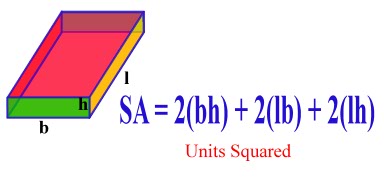
Each triangle has a side length s and height (also the apothem of the regular hexagon) of. Derivation of the area formulaĭivide the regular hexagon into six equilateral triangles by drawing line segments to opposite vertices. Using a grid made up of 1 mm squares is 10 times more accurate than using a grid made up of 1 cm squares. The surface area of the prism is equal to the total area covered by the faces of the prism. The smaller the unit square used, the higher the accuracy of the approximation. The volume of the square Prism equals the Area for square × height. The Lateral Surface Area of Hexagonal Prism formula is defined as the quantity of plane enclosed by all the lateral surfaces (that is, top and bottom faces are excluded) of the Hexagonal Prism is calculated using Lateral Surface Area of Hexagonal Prism 6 Base Edge Length of Hexagonal Prism Height of Hexagonal Prism. However, it is only an approximate value of the area. This method can be used to find the area of any shape it is not limited to regular hexagons.
Surface area of a hexagonal prism formula full#
The regular hexagon to the right contains 17 full squares and 10 partial squares, so it has an area of approximately: Worksheet to calculate the surface area and volume of a rectangular prism. We can also use the formula: Surface area of prism 2 × area of base + perimeter of base × height. Step 3: Add up all the areas to get the total surface area. The regular hexagon on the left contains 6 full squares and 10 partial squares, so it has an area of approximately: Step 1: Determine the shape of each face. The grid above contains unit squares that have an area of 1 cm 2 each. Volume of a Pentagonal Prism (5/2) × Base × Height × Length. Surface Area of a Pentagonal Prism 5 × Base × Height + 5 × Base × Height. The Pentagonal Prism Formulas are, Base Area of a Pentagonal Prism (5/2) × Base × Height. Below is a unit square with side lengths of 1 cm.Ī grid of unit squares can be used when determining the area of a hexagon. A pentagonal prism is a prism that has five rectangular faces and two parallel pentagonal bases. Total Surface Area (TSA) 7 2 × a 2 × cot ( 7) + 7 a h, here a base edge, h height, cot /7 2.0765. It is measured in square units such as m 2, cm 2, mm 2, and in 2. The area formula using the apothem is:Īnother way to find the area of a hexagon is to determine how many unit squares it takes to cover its surface. The surface area (or total surface area) of a heptagonal prism is the entire amount of space occupied by all its outer surfaces (or faces). The apothem, a, of a regular hexagon is half of the distance between opposite sides of the hexagon. An hexagonal prism is made up of 6rectangle faces and 2 hexagon.

The surface area of a prism is equal to the sum of the areas of its faces. Hexagonal Prism Surface Area Formula: 6 R+ 2B Where: R the Area of a Rectangle Face B the Area of an Hexagonal Face. In such a case, the area of the hexagon is: clearBoth Hexagonal Prism Surface Area Formulas. Sometimes, in real life, it is easier to measure the distance between opposite sides of a regular hexagon.

Plugging the side length into the area formula: Given that the perimeter is 72, the length of each side of the regular hexagon can be found by dividing the perimeter by 6, making each side length 12. The types of prisms are rectangular prism, triangular prism, pentagonal prism, and hexagonal prism.Ī Prism that has 2 parallel rectangular bases and 4 rectangular faces is a Rectangular Prism.Find the area of a regular hexagon that has a perimeter of 72. They are named based on the base shape of a prism.

he height of the prism is the common edge of two adjacent side faces.With every lateral face, one edge in common with the base and also with the top.Each face is a parallelogram except the base and top.The base and top are parallel and congruent.Here are some properties of the prism, such as: In the case of minimum deviation, ∠r1 = ∠r2 = ∠rĪ + δ = i1 + i2 (∵ In the case of minimum deviation i1 = i2 = i and δ = δm)


 0 kommentar(er)
0 kommentar(er)
